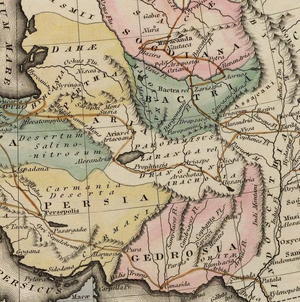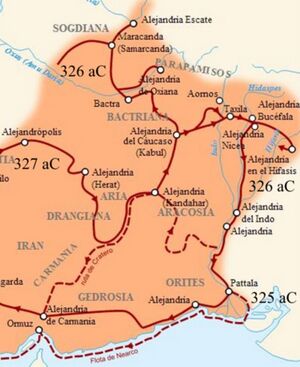Drangiana
| Author: Laxman Burdak, IFS (R). |



Drangiana (द्रांगियाना) was the ancient name of Baluchistan province in Pakistan. It is also called Zarangiana (Greek: Δραγγιανή, also attested in Old Western iranian as Zranka[1] was a historical region and administrative division of the Achaemenid Empire. It may be identified with modern Zaranj in Iran. Rajatarangini has mentioned it as Dranga (द्रंग). [2]
Variants of name
- Zarangaeans (Anabasis by Arrian,p. 193, 344, 361, 378.)
- Drangiana and Drangians (Anabasis by Arrian, p. 183, 193, 196, 239, 341, 387.)
- Drangæ/Drangae (Pliny.vi.21), (Pliny.vi.25)
- Drangiyana (द्रांगियाना) (AS, p.455)
- Dranga (द्रंग)
- Drangian
- Drangians
- Zarangiana
- Zaranj
- Zarin
- Zranka
- Zarangaeans (Arrian:3.25)
- Sarang
- Sarangian (of Herodotus III, 93)
- Sarangæ/Sarangae (Pliny.vi.18)
- Sarangai
Jat Gotras Namesake
- Darag = Drangæ (Pliny.vi.21), (Pliny.vi.25)
Jat Gotras Namesake
- Darag = Drangiana and Drangians (Anabasis by Arrian, p. 183, 193, 196, 239, 341, 387.)
Jat Gotras Namesake
- Darag = Drangiana and Drangians (Anabasis by Arrian, p. 183, 193, 196, 239, 341, 387.)
Location
This region comprises territory around lake Hâmûn, wetlands in endorheic Sīstān basin on the Irano-Afghan-Pakistan border, and its primary watershed Helmand river in what is nowadays southwestern region of Afghanistan and the Chagai region of western Pakistan.
History
In ancient times Drangiana was inhabited by an Iranian tribe which the ancient Greeks called Sarangians or Drangians. Drangiana was possibly subdued by another Iranian people, the Medes, and later, certainly, by the expanding Persian Empire of Cyrus the Great (559-530 BC).[3]
According to Herodotus, during the reign of Darius I (522-486 BC), the Drangians were placed in the same district as the Utians, Thamanaeans, Mycians, Drangians, and those deported to the Persian Gulf.
The capital of Drangiana, called Zarin or Zranka (like the Province), is identified with great probability with the extensive Achaemenid site of Dahan-e Gholaman southeast of Zabol in Iran.[4] Another significant center was the city of Prophthasia, possibly located at modern Farah in Afghanistan.[5] On occasion Drangiana was governed by the same satrap as neighboring Arachosia. In 330-329 BC, the region was conquered by Alexander the Great.[6] Drangiana continued to constitute an administrative district under Alexander and his successors. At Alexander's death in 323 BC, it was governed by Stasanor of Soloi, and later, in 321 BC, it was allotted to another Cypriot, Stasandros. By the end of the 4th century BC, Drangiana was part of the Seleucid Empire, but in the second half of the 3rd century BC it was at least temporarily annexed by Euthydemos I of Bactria. In 206-205 BC Antiochos III (222-187 BC) seems to have recovered Drangiana for the Seleucids during his Anabasis. The history of Drangiana during the weakening of Seleucid rule is unclear, but by the mid-2nd century BC the area was conquered by the expanding Parthian Empire of the Arsacids.[7] == In Rajatarangini
Rajatarangini[8] tells us ... At this time, in the mouth of Shravana, the grateful king (Simhadeva) went to Vijayeshvara to welcome the victorious lord of Kampana. In the meantime Utpala who was coming from Pinchadeva at Shurapura was murdered by the lord of Dranga in a mountain cavern. He was returning from Pushpananada in order to serve Pinchadeva, when he was found out by the lord of Dranga who was secretly looking out for him. But the lord of Dranga was thrown on the ground and was on the point of death. His knee was pierced with arrow. He killed a soldier of the enemy's party whom he found by him. The king, after he had bestowed favors on the lord of Kampana, was on his return. He stopped at the gate of Avantipura when Sura of Dranga bowed to him.[VIII (i), p.136]
Rajatarangini[9] tells that....Koshtaka imprisoned the chiefs of the several departments of government, and, like a king,- collected rent from the subjects in Dranga, in his own name, and left no money in Sindhu. (VIII (i), p.178)
Rajatarangini[10] tells that....Pinjadeva, lord of Dranga, attended by a handful of warriors, such as were not sufficient even to count the soldiers of Lothaka, sent the latter in the direction of death or in the river. A multitude of blazing pyres were reflected in the river, and it seemed, as if the last rites of those who were drowned were being performed. Thus one day, Lothaka, forgetful of death, and taking with him his faithful men, fought an arduous battle and on the next day, he was beaten back with a broken force. He had thought that it would be easy to take within two or three days that lonely town in which he had collected an army from all sides. [VIII (ii),p.255]
Mention by Pliny
Pliny[11] mentions 'The Nations of India'....However, that we may come to a better understanding relative to the description of these regions, we will follow in the track of Alexander the Great. Diognetus and Bæton, whose duty it was to ascertain the distances and length of his expeditions, have written that from the Caspian Gates to Hecatompylon, the city of the Parthians, the distance is the number of miles which we have already12 stated; and that from thence to Alexandria,13 of the Arii, which city was founded by the same king, the distance is five hundred and seventy-five miles; from thence to Prophthasia,14 the city of the Drangæ, one hundred and ninety-nine; from thence to the city of the Arachosii,15 five hundred and sixty-five; from thence to Ortospanum,16 one hundred and seventy-five; and from thence to the city built by Alexander,17 fifty, miles. In some copies, however, the numbers are found differently stated; and we find this last city even placed at the very foot of Mount Caucasus!
13 See c. 25 of the present Book.
14 See c. 25 of the present Book.
15 See c. 25 of the present Book.
16 A town placed by Strabo on the confines of Bactriana, and by Ptolemy in the county of the Paropanisidæ.
17 See c. 25 of the present Book.
Mention by Pliny
Pliny[12] mentions The Ariani and the adjoining Nations.....We then come to the nation of the Dorisdorsigi, and the rivers Pharnaracotis20, and Ophradus; and then to Prophthasia21, a city of the Zaraspades, the Drangæ22, the Evergetæ23, the Zarangæ, and the Gedrusi24;
20 Ansart suggests that the river Pharnacotis is the same as the modern Ferrichround, and the Ophradus probably the Kouchround.
21 Ansart suggests that the modern name is Zarang. Parisot says that it is Corcharistan.
22 The inhabitants of Drangiana, a district at the eastern end of the modern kingdom of Persia, and comprehending part of the present Sejestan or Seistan.
23 They gave its name to the modern Eudras, according to Parisot.
24 It is doubtful whether these are the same as the Gedrosi, mentioned by Pliny in c. 23, 24. Parisot censures Hardouin for confounding them, and says that these inhabited the modern Bassar. In Dr. Smith's Dictionary, they are looked upon as the same people.
द्रांगियाना
विजयेन्द्र कुमार माथुर[13] ने लेख किया है ...द्रांगियाना (AS, p.455) द्रांगियाना भारत के पड़ोसी देश पाकिस्तान के बलूचिस्तान का प्राचीन नाम है। 'अलक्षेन्द्र' (सिकन्दर) के जमाने के यूनानी लेखकों ने भी इसका उल्लेख किया है। यह कहना संभव नहीं है कि द्रांगियाना किस भारतीय नाम का यूनानी रूपान्तर है।
जाट इतिहास
ठाकुर देशराज[14] लिखते हैं कि समोस द्वीप : यह द्वीप एजियन सागर में है। एशियाई रोम के ठीक पच्छिमी किनारे पर बसा हुआ है। यहां जो जाट समूह गया था, वह क्षौथी (Xuthi) कहलाता था। क्रुक साहब ने ‘ट्राइब्स एन्ड कास्टस आफ दी नार्थ वेस्टर्न प्राविन्शेज एन्ड अवध’ नामक पुस्तक में लिखा है -
- "Their course from the Oxus to Indus may, perhaps, be dimly traced in the Xuthi of, Dianosius of Samos and the Xuthi of Ptolemy who occupied the Karmanian desert on the frontier of Drangiana."
इसी बात को जनरल कनिंघम साहब ने अपनी तवारीख में इस भांति लिखा है -
- "Xuthi of Dianosius of Samos were Jatii or Jats, who are coupled with the Ariene and in the Xuthi of Ptolemy, who occupied the Karmanian desert on the frontier of Drangiana. (Cunningham Vol.II P.55)
अर्थात् - सामोस के डाईनीसीअस के क्षूति जटी या जाट थे जो ऐर्रानी से टोलेमी के जूथी में मिल गए, जिन्होंने ड्रेनजिआना के सीमांत के करमानिया के ऊपर अधिकार कर लिया।
External links
References
- ↑ Schmitt, Rüdiger (15 December 1995). "DRANGIANA or Zarangiana; territory around Lake Hāmūn and the Helmand river in modern Sīstān". Encyclopædia Iranica.
- ↑ Book VIII (i) (p.136, 178); Book VIII (ii) (p.245, 255)
- ↑ Schmitt (1995)
- ↑ G. Gnoli, "Dahan-e Ḡolāmān," Encyclopaedia Iranica, vol. 6 (1993) 582-585.
- ↑ Schmitt (1995)
- ↑ Schmitt (1995)
- ↑ Schmitt (1995)
- ↑ Kings of Kashmira Vol 2 (Rajatarangini of Kalhana)/Book VIII (i) ,p.136
- ↑ Kings of Kashmira Vol 2 (Rajatarangini of Kalhana)/Book VIII (i),p.178
- ↑ Kings of Kashmira Vol 2 (Rajatarangini of Kalhana)/Book VIII (ii),p.255
- ↑ Natural History by Pliny Book VI/Chapter 21
- ↑ Natural History by Pliny Book VI/Chapter 21
- ↑ Aitihasik Sthanavali by Vijayendra Kumar Mathur, p.455
- ↑ Jat History Thakur Deshraj/Chapter VI, p.193-194
Back to Jat Places in Pakistan/Jat Places in Iran

